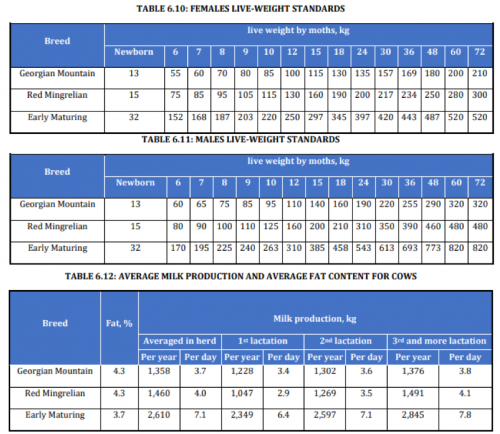Keywords: livestock characterization | expert judgement | herd modeling
Country context: Georgia is a country in the Transcaucasus region that lies between Eastern Europe and Western Asia. The common native cattle breeds Georgian Mountain and Red Mingrelian cattle are late maturing breeds, characterized by small body size and low milk yields with high fat content. Intensive production systems are limited, and most cattle are raised in extensive grazing systems. During the period of the Soviet Union, more productive early maturing breeds were introduced. Georgia’s GHG inventory began to use a Tier 2 approach for cattle in 2009. Prior to that, a Tier 1 approach was used by applying the IPCC default for the Asia region to late maturing breeds and the default values for Easter Europe to the early maturing breeds.
What data needs were addressed? Adopting a Tier 2 approach requires more detailed characterization of the cattle population, including sub-categories of cattle. However, national statistical data does not report any sub-categories of cattle.
Why was the data needed? Cattle account for about 90% of enteric fermentation emissions in Georgia. Enteric fermentation is a key source in the national GHG inventory. Therefore, following IPCC Guidance, a Tier 2 approach to estimation should be adopted, including enhanced characterization of cattle.
Methods used: Expert judgement for distribution of population among breeds; herd modelling for structure of the herd among age-sex groups.
How were livestock characterized? Georgia’s GHG inventory categorizes cattle by breed as Georgian Mountain breed, Red Mingrelian or early maturing breed. This is because the characteristics of each breed differ (e.g. in terms of animal weight, milk production, fertility etc). Within each breed (or breed type), cattle are categorized into 17 types: 3 age groups of cow, 3 age groups of lactating cow, 3 age groups of bull (castrate), 3 age groups of bullocks, 3 age groups of heifers, and male and female calves <1 year old. Emission factors are estimated separately for each age-sex category for each breed.
The proportion of each breed in the whole cattle population was estimated using expert judgement. Then, within each breed, the annual population of each sub-category was estimated using a simple herd model based on the following assumptions:
- Early maturing cattle have first calving at 3 years old, and are mature at 5 years old.
- Late maturing cattle have first laving at 4 years old and are mature at 6 years old.
- The average lifetime of an animal is 15 years.
- A cow’s gestation period is 9 months, with lactation for 12 months and a 2 month dry period.
- The sex ratio of calf births is 50:50.
- With a preference for veal, the calf slaughter ratio is higher and slaughter is assumed to take place in the middle of the year.
By applying these rules in a monthly time step model, the age and sex structure of the cattle population of each breed changes on a monthly basis and annual population estimates can be derived, considering the number of months each animal type is alive. Emission factors for each sub-category of animal are then estimated on the basis of age, sex and breed-specific characteristics (see examples in Tables 1-3), which are then applied to the modeled population to estimate total emissions.

Source: Georgia NIR 2016
Photo by Daniil Nenashev/World Bank
Author: Andreas Wilkes, Values for development Ltd (2019)

